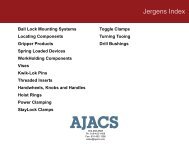Vibro/Dynamics Catalog - Ajacs Die Sales Corporation
Vibro/Dynamics Catalog - Ajacs Die Sales Corporation
Vibro/Dynamics Catalog - Ajacs Die Sales Corporation
You also want an ePaper? Increase the reach of your titles
YUMPU automatically turns print PDFs into web optimized ePapers that Google loves.
The anvil’s inertia is used to generate the blow force. Softer isolation systems will slightly decrease the peak force of the blow. Both elastomer and<br />
spring type isolation systems reduce the available impact force to approximately 99.985% of the force compared with traditional timber support.<br />
Because only 0.015% is lost by employing a more efficient isolation system, the benefits to the hammer, foundation, personnel, and nearby equipment<br />
easily justify using an economical and reliable isolation system.<br />
All hammer blows occur over a very short time compared to the<br />
oscillations of the anvil after the blow is struck. See Figure 2. The time for<br />
one oscillation of the anvil is the natural period of the hammer system.<br />
Traditional hammer support systems using oak timbers may be used<br />
as a benchmark for the performance for other isolation systems. Even<br />
with timber support, the natural period of the hammer system is much<br />
greater than the shock impulse duration of the ram striking the work. The<br />
difference results in a significant reduction in the force transferred from the<br />
anvil to the foundation. However, because the blow forces are extremely<br />
large, even small levels of vibration transmitted to the surroundings may<br />
be very disruptive and damaging. In general, the softer the support<br />
system, the greater the natural period and isolation effectiveness. The<br />
transmitted shock of the hammer will be reduced if the system natural<br />
period is at least six times greater that the shock force duration. Soft<br />
systems transmit less vibration to the surroundings than stiff systems.<br />
The collision between the ram and workpiece transfers the momentum of<br />
the ram into downward motion of the anvil and the upward rebound of<br />
the ram. Once the ram and anvil reach the same velocity the ability of the<br />
ram to do work is finished, and the maximum force on the workpiece is<br />
achieved. After this point in time, the ram rebounds upwards and the anvil continues to travel downwards.<br />
When the ram rebounds<br />
Once the work has been done on the workpiece and the ram is rebounding, the impact shock from the ram is transferred to the anvil and the isolation<br />
system controls the motion and transmitted forces. Because the shock impulse is of very short duration, the hammer system can be accurately modeled<br />
by using the conservation of momentum principle. Because some energy is lost in the impact of the ram upon the workpiece, the collision is termed<br />
inelastic, but the conservation of momentum laws still apply.<br />
Where:<br />
m 1 = ram mass<br />
m 2 = anvil mass<br />
v i = ram velocity immediately before impact<br />
v 2i = anvil velocity immediately before impact<br />
v f = ram velocity immediately after impact<br />
v 2f = anvil velocity immediately after impact<br />
The ram will not rebound at the same velocity; this change can be captured in the Coefficient of<br />
Restitution, C , defined by Equation 4.<br />
R<br />
Open die forging operations that cause very large deformations in a hot work piece will have<br />
very low C values of 0.1-0.2. As the work piece cools with very little deformation taking place, as in<br />
R<br />
the case of finishing blows in a closed die forging, C values may be as high as 0.5-0.6.<br />
R<br />
The hammer system can be modeled very effectively as a single degree of freedom system where<br />
the supporting isolation material is a simple spring and dashpot as shown in Figure 3. The dynamic<br />
stiffness, K , of the isolation system determines the amount of motion and the amount of force<br />
transferred to the foundation.<br />
The damping component, ξ, of the system dissipates energy as heat as the system is brought<br />
back to the static state of equilibrium. The damping has little effect on the first downward peak<br />
displacement of the anvil, but over several cycles the anvil slows to the at rest state.<br />
After the ram has struck the work piece and the momentum of the ram is transferred to the anvil, the<br />
anvil will oscillate about the equilibrium position upon the isolation system at a frequency, called the<br />
damped natural frequency of the system, given by Equation 5.




